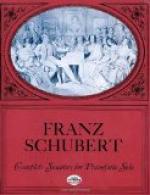A little later than Mattheson (i.e. in 1721), Pier Giuseppo Sandoni, husband of the famous vocalist Cuzzoni, published at London “Sonate per il Cembalo,” dedicated to the Duchess of Pembroke. No. 1, in D minor, has three movements, an Allemande, Largo, and Giga Presto; they are all short, and in two sections; and, as a rule, the writing is in two parts. No. 2, in F, opens with an Allegro of peculiar form. It has four sections, each of which is repeated; the first (seven bars) modulates to the key of C, closing thus—
[Music illustration]
The second section (also consisting of seven bars) soon modulates to D minor, closing in that key in a manner similar to the first. The third section (ten bars) consists of modulation and slight development, and closes in A minor. The fourth section (fifteen bars) passes by means of broken chords (in imitation of the last bar of the previous section) through various keys, ending in the same fashion as the first section, only, by way probably of intensification at the end, there are seven instead of four quaver chords; the section, of course, ends in F. This movement in the matter of form offers an interesting link between Kuhnau and E. Bach. The second movement is a minuet, with variations; it certainly has a beginning, but seems endless. The 3rd Sonata, in A, resembles No. 1 in form, also in grouping of movements.
And in addition to the sonata of Mattheson, the Sei Sonatine per Violino e Cembalo, di Georgio Philippo Telemann, published at Amsterdam in 1721, will give us an approximate idea of the clavier sonata between Kuhnau and Emanuel Bach. Each number, by the way, is headed—title-page notwithstanding—a sonata. No. 1, in A major, consists of four movements, Adagio, Allegro, Largo, Allegro, and all the four are in binary form. The second is naturally the most important; the others are very short and simple. In this Allegro, besides the allusion in the dominant key to the theme at the opening of the second section there is a return to it, after modulation, in the principal key. Some of the other sonatas are longer, but No. 1 represents, roughly, the other five as to form and contents. No. 6, in F, by the way, has only three movements: Vivace, Cantabile, and Presto.




